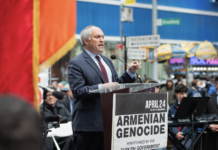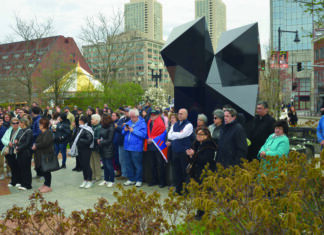BOSTON (Art New England) — Something beautiful and powerful emerged from the Big Dig, Boston’s largest and most expensive, urban renewal project of the 20th century — the Rose Fitzgerald Kennedy Greenway, a gorgeous greenspace where the ghastly Central Artery and Interstate 93 once loomed. Stretching one-and-one-half miles, The Greenway is speckled with lush flora and fauna, fountains, installations of public art, food trucks, carousel, and the Armenian Heritage Park with its outdoor sculpture and labyrinth.
The year 2022 marks the 10th anniversary of the park. After numerous discussions with former Boston Mayor Thomas Menino, state officials, and the Massachusetts Turnpike Authority, the Armenian Heritage Foundation, who raised the funds for the construction of the park, was granted parcel 13 on The Greenway.
The prestigious architectural firm, Tellalian Associates Architects & Planners, was commissioned to layout the space. Don Tellalian, AIA, assembled a Design Concept Committee, including an attorney, an architect, a student, a health-care professional, and representatives from the Armenian-American community of Boston.
Tellalian, renowned in the region, was the principal architect, and designed Abstract Sculpture in the Park as a split rhomboid dodecahedron (solid geometry). In geometry, a dodecahedron is any polyhedron with 12 faces. When asked why he chose geometric art, Tellalian explained, via email, “As an architect, one might say that geometry is our language. But for the park, the geometric figures had to have meaning and engage all ages.” The sculpture is dedicated to those who lost their lives in the Armenian Genocide from 1915 to 1923.
Each spring, Abstract Sculpture is given a new look. A crane pulls it apart and once its core is exposed, Tellalian, referring to the manual he wrote for the process, rearranges the sculpture into various designs depending on the year.
Each page of the manual carries a date, for example, Abstract Sculpture Year 11-2022, along with instructions and diagrams showing how to pull apart the work and reshape it into a stacked configuration. Next year, Year 12-2023, it will be a different stacked formation; Year 13-2024, a leaning arrangement; and so forth, until 2036 when the design reverts back to 2012.









